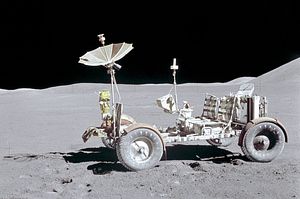North Korean leader Kim Jong-un has set himself a challenge that’s out of this world: planting his country’s flag on the moon within a decade.
Pyongyang’s answer to NASA is engrossed in a five-year plan to put more sophisticated satellites into orbit by 2020, and the experience will inform a lunar mission within the next 10 years. That’s according to an interview with a senior official at the National Aerospace Development Administration (NADA), published by the Associated Press on Thursday.
“Even though the U.S. and its allies try to block our space development, our aerospace scientists will conquer space and definitely plant the flag of the Democratic People’s Republic of Korea on the moon,” Hyon Kwang Il, NADA’s director of scientific research, told the AP.
The plan, he said, was directed by the supreme leader himself.
While audacious, the bid — which follows the appearance of several articles about Kim’s supposed lunar ambitions on the satirical news website The Onion — is not necessarily fantastical.
Experts quoted by the AP said an unmanned mission to the moon would not be inconceivable, but would require a major upgrade — more giant leap than small step — of the country’s technological capabilities.
“Reaching the moon is much harder than putting something into Earth orbit,” Markus Schiller, an aerospace engineer at Munich-based ST Analytics, told The Diplomat.
North Korea has yet to develop a rocket powerful enough to escape the Earth’s orbit, Schiller said, a crucial step to carrying out even the most basic lunar mission, a “hard impact” on the Moon.
“Developing a larger rocket will take a long time, and pulling off a successful mission even much longer,” Schiller said. “If they continue at the same pace as before, it will take them a decade at least to have a hard moon impact.”
North Korea has attempted a raft of medium and long-range rocket launches this year, often using its space program as a justification.
In February, it launched a satellite, the Kwangmyongsong 4, into space in a move widely condemned by the international community as a pretext to test banned ballistic missile technology. The launch, which followed the country’s fourth successful nuclear weapons test the previous month, provoked a further round of punishing UN sanctions against the regime.
A successful lunar mission would have considerable propaganda value for the impoverished and increasingly isolated country, which has committed to developing nuclear weapons and its moribund economy in unison, a policy known as “byungjin.”
“‘Byungjin’ is a pragmatic guideline designed to maximize the efficiency of economic development and strengthen national defense ‘in accordance with the state of affairs.’ It permits the DPRK to mirror the actions of its friends and enemies and exercise the policy of ‘strategic patience’ in negotiations,” said Leonard Petrov, a Korean specialist at Australian National University.
“Just like JFK effectively demonstrated to the world that American missiles were precise enough to hit any target, the North Koreans are doing the same to create a furor at home and abroad.”

































